IxDA Student Design Charette adventure - The contest!
I chose to learn Interaction Design because I think there are no good things than an interactive experience that make people feel concerned.
Whether during my 3 years of Interaction Design studies at L'Ecole de design Nantes Atlantique, whether, during my first internship at Emotic, a French digital agency whose guideline is "Without emotion, progress is nothing", I learn that: For good user experiences, it is necessary to arouse emotions to the user. For this, you have to understand the user to create an object or a service that corresponds to him. That is why we have to put ourselves "in his shoes" and live his emotions to better identify his needs and expectations. And so, we create a service, digital or not, more empathic and inclusive.
When I discover the first subject of the Student Design Charette was about "empathy" I told to myself "This is for me!".
I arrived earlier in Seattle, I wanted to adapt myself to jet lag and enjoy visiting the city before the contest.
Tuesday 5th of February
The first day of the contest I met all the participants in the Westin Hotel lobby. We went all together to the School of Art where people from IxDA were waiting for us for breakfast.
We present ourselves and then began differently "breaking glass" exercises.
- Firstly, we had to write down all our "superpowers", our strengths. This comforting us, letting us known that we are able to do what we were here to do. It is a hard exercise but very helpful to understand ourselves, the others and their passions.
- Then, for the second exercise, we had to hide our eyes. We had to find a rope hiding in the room but we were not allowed to speak. When we thought that we were all holding the rope we were allowed to talk again. Then we were asked to make a square altogether, still with the eyes hidden but we were allowed to talk. This exercise was very interesting: firstly, we put ourselves in the situation of a blind person, we lost our marks and we had to find a way to communicate without words, secondly, this exercise helps us to know more about the personality of each one, the one who will talk to find the solution, the one who will listen, the other who will try to do what they said, the other who will defend another idea, etc. This exercise helped to create teams.
Next Margaret Price, a principal design strategist at Microsoft and co-lead of the Student Design Charette, presented a master class about empathy and inclusive design at Microsoft. She asked us to do an exercise: think about an attraction playground you like to play when you were young, now think about people who were excluded from this kind of attraction, and then think about what kind of solution we could build to include them in this experience. Now, for all my project I want to think like that! This is a simple thought but thanks to this reflection we can build great things. "Solve for one, expand to all".
Then we meet experts: Dr. Patricia Worthey, Dr. David Smith, Belle Archaphorn and Zaki Hamid. They were here to help us to better understand the brief, give their definition of empathy and inclusion design and showcased how empathy is applicated in today's world.
Split into two groups, we brainstormed on everything we could remember from this presentation. It was very helpful to better understand the subject, having reformulation with our words.
Then came the time to announce the teams! I was in a group with Kasper Burghout (Hyper Island Manchester) and Catherine Woodiwiss (Austin Center for Design).
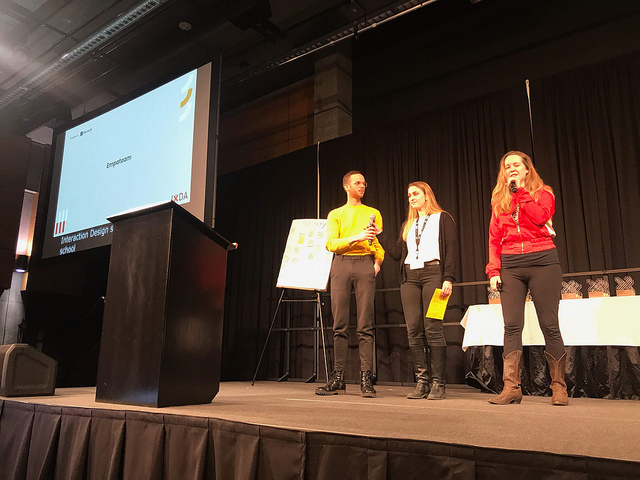
We make a team canvas, it takes time but helps us to better understand our goal in this project.
We discussed different insights and we did a first round of "how might we...". And we onclude on "How might we support teams who want to bring their full selves to work, by unlocking inclusivity?".
We focused on which people we could interview which will match to our spectrum persona profile.
That night, during the opening party, we interviewed different people who fit our project. We went to the Seattle Art Museum. We met people from Instagram, Facebook, Microsoft, AirB&B, and many others. I could meet also the leaders of different IxDA associations in the world. It was a great time during which I could see that IxDA is a very big family and I am very happy to join this family.
Wednesday 6th of February
After collective research on a big board and synthesizing museum interviews, we continued to do brainstorming.
We did an ideation exercise called the Crazy Eight in which we had to fold a paper in 8 part and in each compartment we drew a variation of our ideas. Thanks to these 24 ideas we selected some and mixed it up.
And we also did an "idea napkin" to detail some of our selected idea and step by step we build our project.
Tursday 7th of February
We did our first prototype in the morning and start to do user testing. We meet people we interviewed during the opening party at the SAM Galery and ask them to try our solution. Thanks to their feedbacks we work again on our prototype in order to create a second version and tested it again.
We filmed every user-testing with their feedback and caught very strong quotes. People open themselves and tell us about their story. They were strangers and they shared with us their experience and strong emotions.
"I liked seeing ‘what shuts me down’ that alleviates shame — cool to think that having things that shut us down is universal."
"I’d include ‘trigger words’. My trans-19-year-old would appreciate that."
"Consider more empowering language — not ‘what is my superpower?’ but ‘what am I skilled at?’"
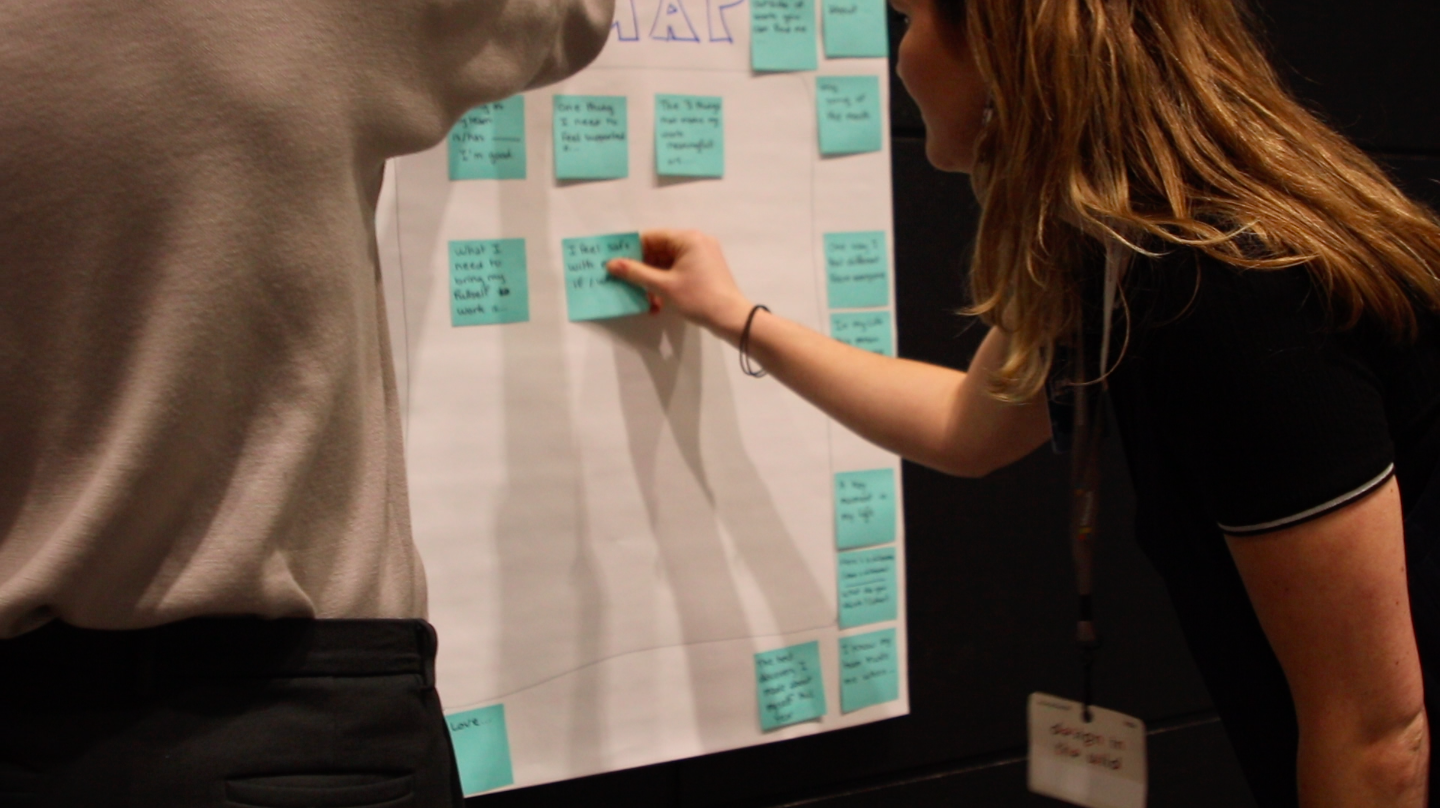
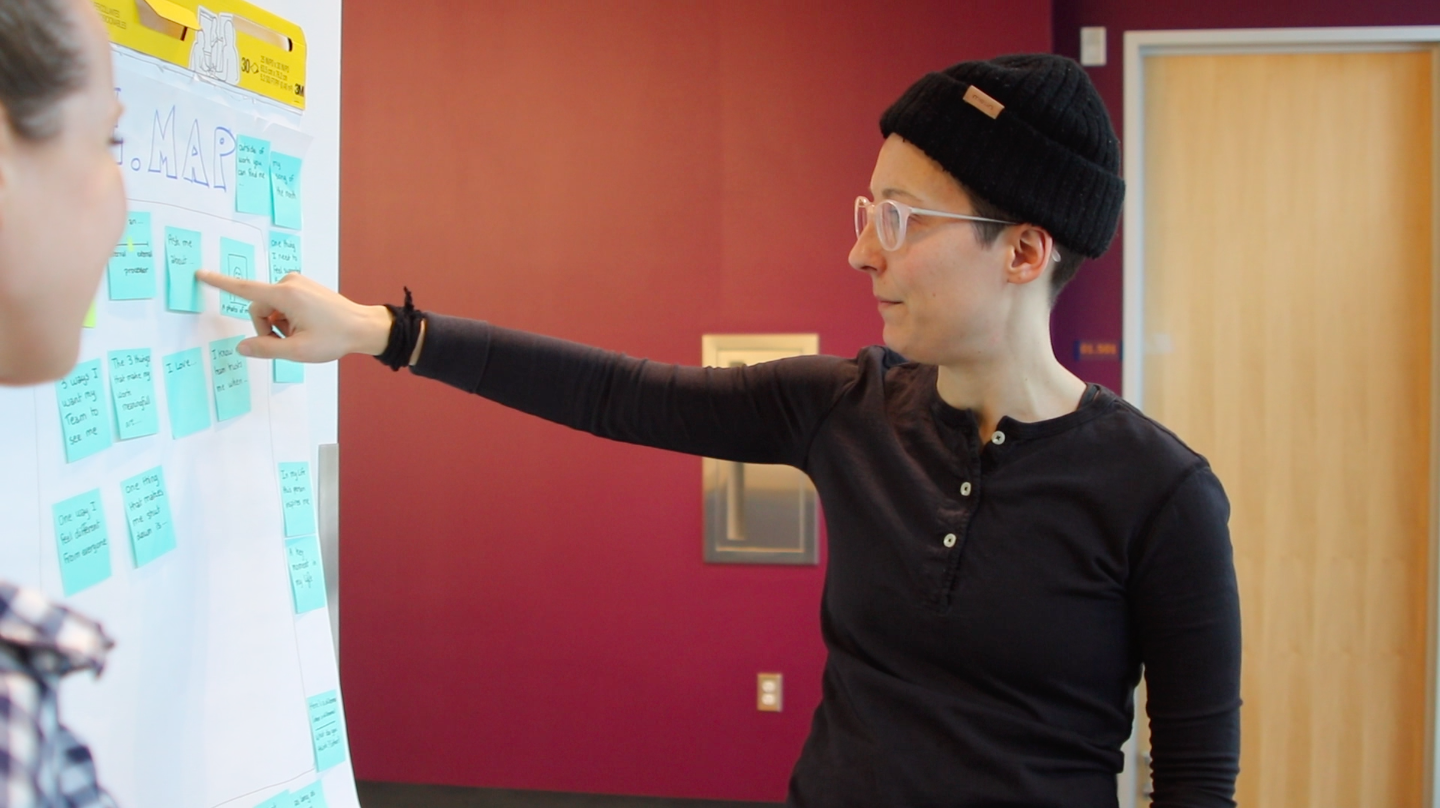
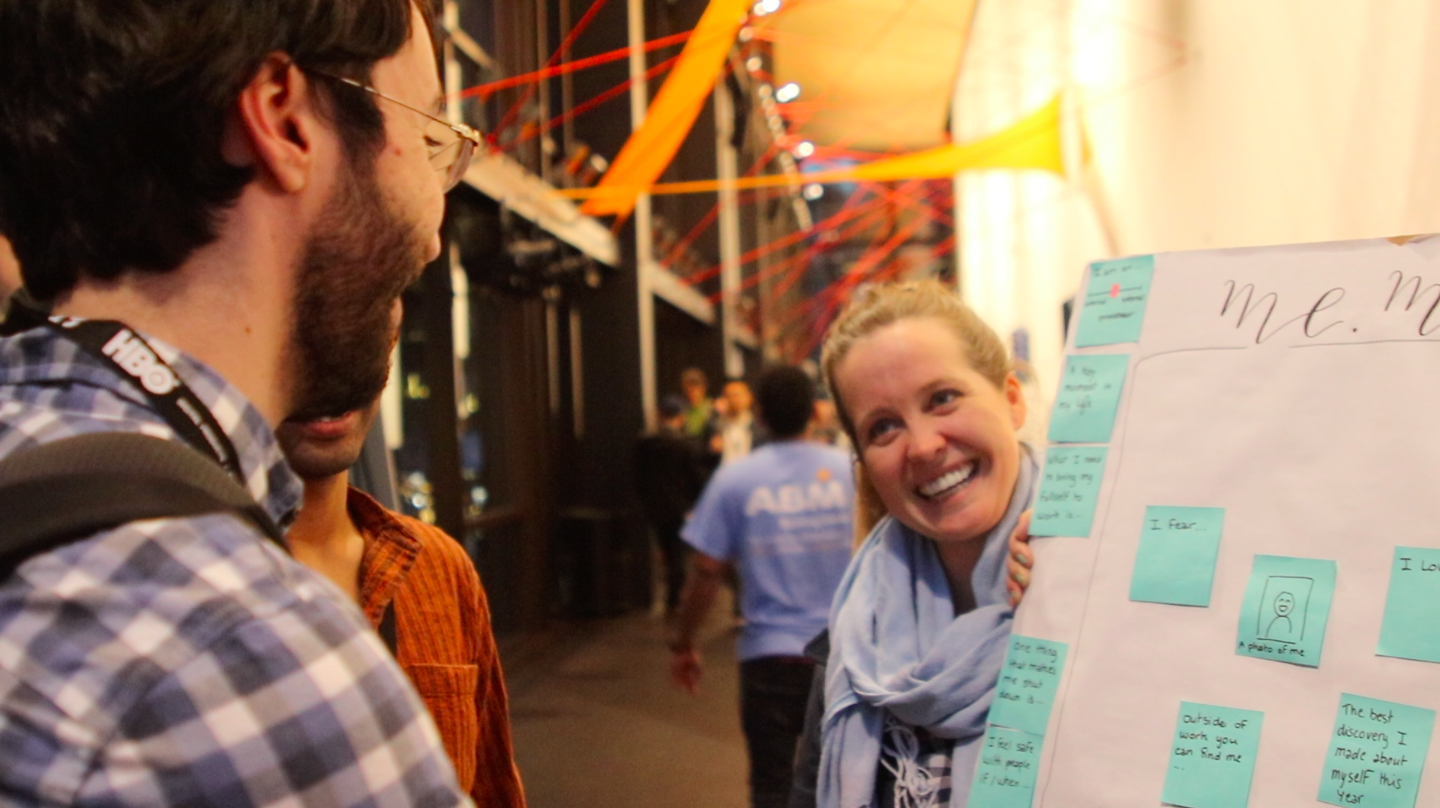
We spend the night working on our final product and the video we had to do. Writing and recording the voice-over, classify and put in order the different video rushes.
Friday 8th of February
After a very small night of 30 minutes and my computer which crashed at 6am (thank you Akshita for helping me to save my computer!), I could finish the video on time for the delivery on Friday 8th of February at noon. Catherine and Kasper were absolutely wonderful for this last home stretch. Due to the weather, the schedule of our last day of competition was very uncertain, changing all the time. Stress and tiredness started to be felt.
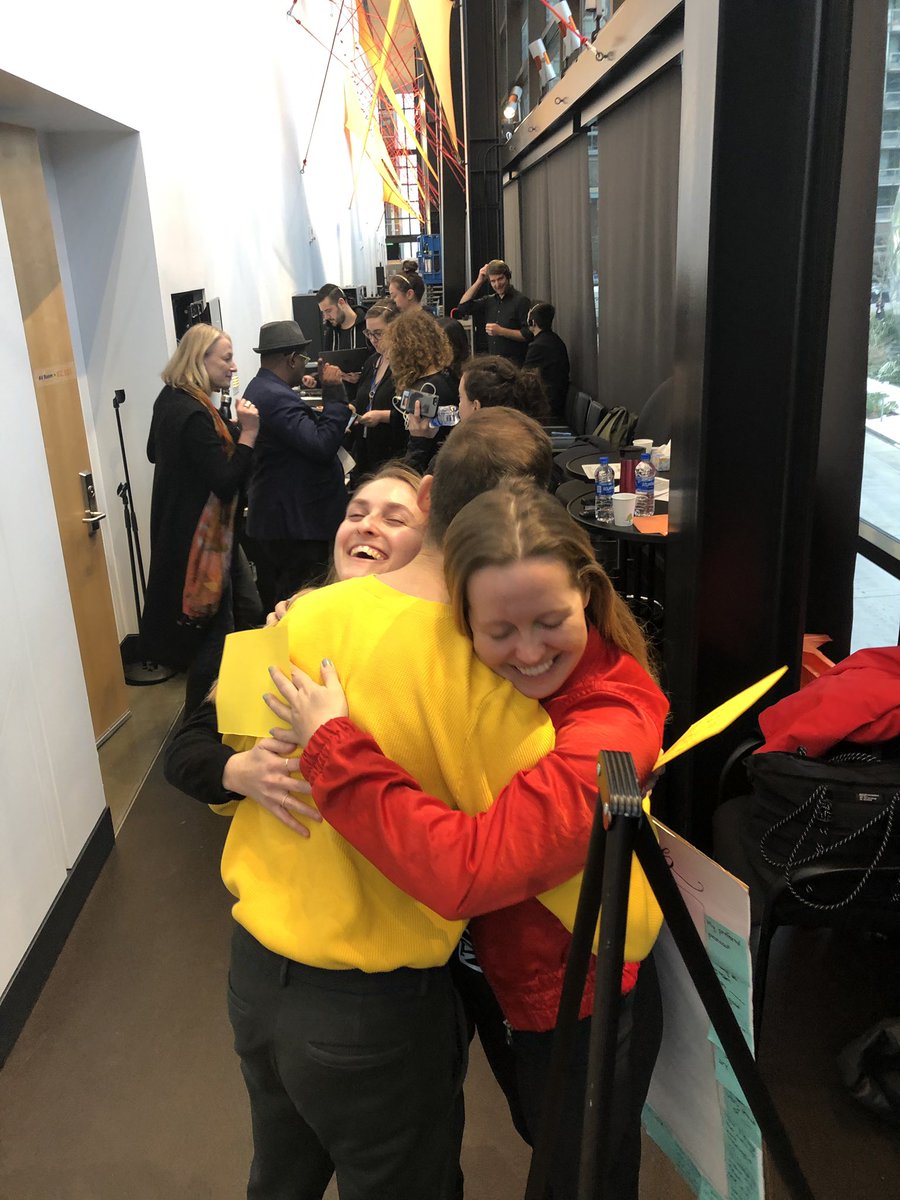
This picture is everything for me. At the beginning of the week, we were strangers for each other and this big hug was the most powerful and emotional moment we had.
Our project
Curious about our project? Take a look at our final presentation.
« Me. Map » to « We. Map »
As designers, we care about building an inclusive world. But we’re limited in how inclusive our products can be if the teams building them struggle to empathize with the stories each of us are carrying.
Empathy means to be aware of the feelings of others and understand their needs. Empathy is an action, not a feeling.
Scaling empathy means to implement this understanding in a variety of sectors, communities, and platforms.
How might we help new hires bring their full authentic selves to their teams?
Me.Map a digital storyboard for teams, to help each team member share their story. Me.Map has prompted to ask questions, get help in solving dilemmas, and share workstyles.
It includes a flexible scale for vulnerability, allowing new hires to choose how much they want, or don’t want, to share around themselves.
This Me.Map lives on your desktop and integrates with the Me.Maps of your team. Users can see common passion projects or triggers, loves, and shared inspiration. It is useful as an onboarding orientation guide, an annual empathy check, or even in the recruitment of new team members.
On its surface, Me.Map helps teams avoid hurtful experiences. It introduces a collaborative way to establish empathy in teams. And helps clarify motivations and values.
Me.Map has potential beyond its current iteration. It can scale empathy…
Me.Map is a simple tool, but one with emergent properties. We believe it’s the start of a new conversation...but it’s certainly not the end.
What did I learn during the competition?
This contest was extraordinary. I had the opportunity to meet people from all over the world, with different experience and background. I could work with people speaking another language, and thanks to them and their experience I learn new methodologies and new exercises. I worked in another way, with my point of view of an interaction design student without working on a digital device.
To satisfied your curiosity
Here are some links related to this competition:
SDC 2019 brief: "Empathy at scale" Daniel Harvey's Medium article: "Meet the Student Design Charette Finalists" "IxDA Student Design Challenge: Designing Their Heart Out" written by Ashley Walls, 02/19/2019 "IxDA Student Design Charette 2019" Microsoft Design Twitter "3 Things I Learned from Microsoft’s Student Design Charette" written by Ambika Vohra, 02/18/2019 "IxDA Student Design Projects 2019 Me.Map", Microsoft Design "IxDA Student Design Projects 2019 Me.Map (Audio Description)", Microsoft Design